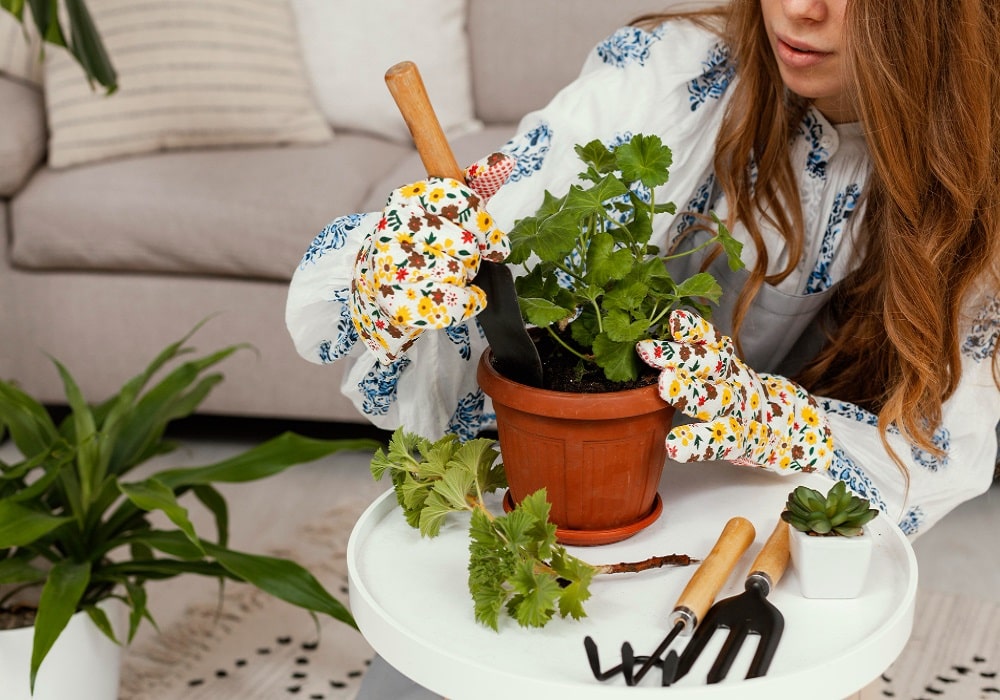Gardening at home is more than just a hobby; it’s a rewarding experience that connects us with nature and allows us to cultivate our own fresh produce or create beautiful outdoor spaces. Whether you’re a novice or seasoned gardener, this guide provides essential tips for gardening at home to help you achieve success in your home garden.
Getting Started with Home Gardening
- Choosing the Right Location
- Select an area in your yard or balcony that receives adequate sunlight and has good drainage.
- Consider proximity to water sources for convenient watering.
- Deciding on Garden Type
- Determine whether you’ll plant a vegetable garden, flower beds, container garden, or a mix of these.
- Tailor your choices based on available space and personal preferences.
Essential Tools and Supplies
- Basic Gardening Tools
- Invest in quality tools such as a trowel, garden fork, pruning shears, and watering can.
- Ensure tools are kept clean and well-maintained for efficient use.
- Quality Soil and Amendments
- Use nutrient-rich soil or amend existing soil with compost to improve fertility and drainage.
- Consider soil pH levels and specific requirements for different plants.
Choosing Plants and Seeds
- Selecting Suitable Plants
- Choose plants suited to your climate zone and growing conditions.
- Research plant characteristics like sunlight, water, and space requirements.
- Starting from Seeds vs. Seedlings
- Decide whether to start plants from seeds indoors or purchase seedlings from nurseries.
- Follow proper germination and transplanting techniques for healthy growth.
Proper Planting Techniques
- Planting Depth and Spacing
- Follow guidelines specific to each plant variety regarding planting depth and spacing.
- Avoid overcrowding to allow for proper airflow and growth.
- Watering and Irrigation
- Establish a regular watering schedule based on plant needs and weather conditions.
- Use techniques like drip irrigation or soaker hoses to conserve water and deliver it efficiently.
Maintaining Your Garden
- Weeding and Mulching
- To avoid competition for nutrients and space, regularly pull weeds.
- Mulch the area surrounding plants to control soil temperature, weed growth, and moisture retention.
- Fertilizing and Feeding Plants
- Use organic fertilizers or compost to replenish soil nutrients periodically.
- Follow recommended feeding schedules for optimal plant health and growth.
Pest and Disease Management
- Identifying Common Pests
- Monitor plants for signs of pests such as aphids, caterpillars, or fungal diseases.
- Employ natural pest control methods like companion planting or introducing beneficial insects.
- Natural and Organic Solutions
- Avoid chemical pesticides and opt for organic solutions like neem oil or insecticidal soap.
- Reducing vulnerability to pests requires maintaining plant health through appropriate nutrition and irrigation.
Harvesting and Enjoying Your Garden
- Knowing When to Harvest
- When fruits and vegetables are fully grown, harvest them for maximum nutrition and flavor.
- Cut flowers for bouquets when buds are just beginning to open for longer vase life.
- Celebrating Your Success
- Share your garden’s bounty with family and friends or preserve harvests through canning or freezing.
- Reflect on lessons learned and plan for future seasons based on your gardening experiences.
Conclusion
Home gardening is a fulfilling journey that allows you to nurture plants, enjoy fresh produce, and create beautiful outdoor spaces. By following these essential tips for gardening at home and techniques, you can cultivate a thriving garden that brings joy and satisfaction throughout the growing season.
FAQs about Gardening at Home
- What are the best plants to grow in a beginner’s home garden?
- Beginners should start with easy-to-grow plants like tomatoes, herbs (such as basil and mint), lettuce, and marigolds. These plants are resilient and provide quick rewards for your efforts.
- How often should I water my garden?
- The frequency of watering depends on factors like weather conditions, soil type, and plant species. As a general rule, most plants need regular watering, typically 1-2 inches per week, adjusted for hot and dry weather.
- How can I prevent pests and diseases in my home garden?
- To prevent pests and diseases, practice good garden hygiene by keeping weeds under control and removing diseased plants promptly. Consider using natural deterrents like companion planting, neem oil, or insecticidal soap.
- When is the best time to plant seeds or seedlings in my area?
- The timing for planting seeds or seedlings varies by region and climate. Consult local gardening guides or extension services to determine the optimal planting times for different crops in your area.
- How can I improve the fertility of my garden soil naturally?
- Improve soil fertility naturally by adding compost, aged manure, or organic fertilizers. Over time, these amendments strengthen the soil’s structure and fill it with vital nutrients.
Read Also – The Ultimate Guide to Growing Kitchen Garden Vegetables in India






